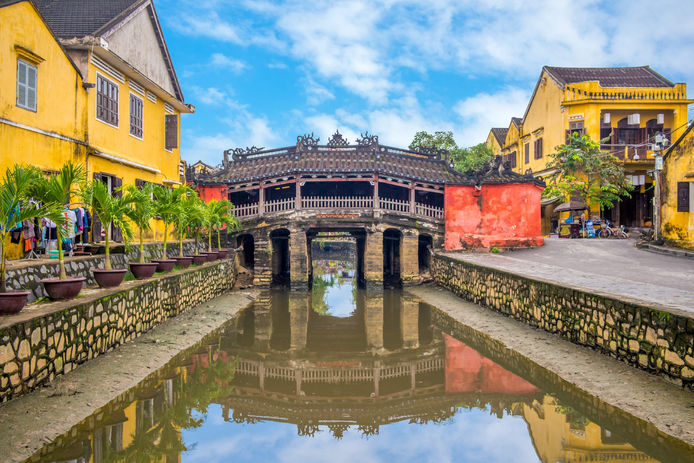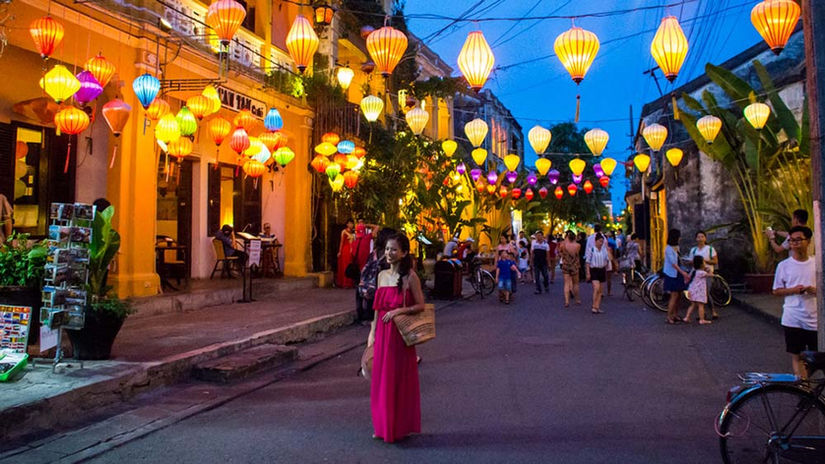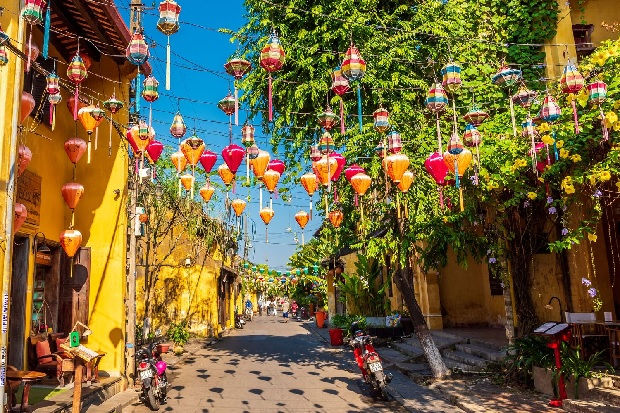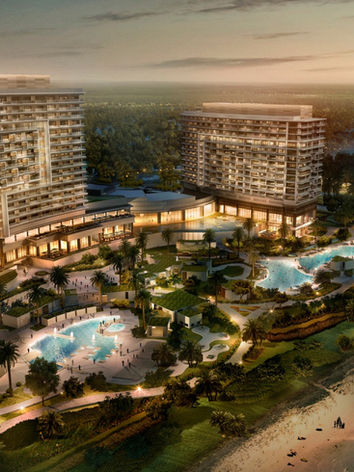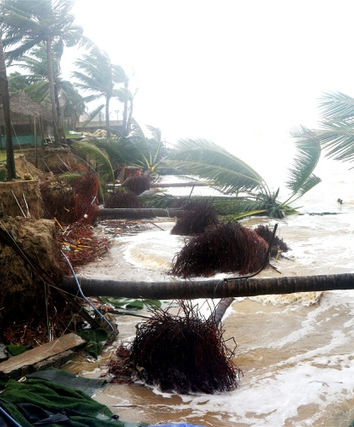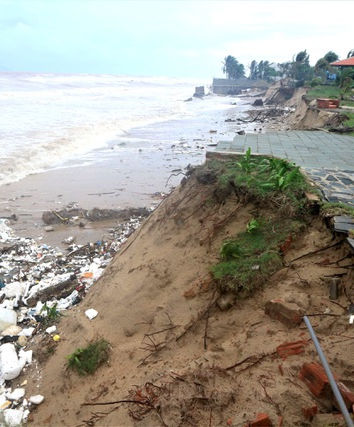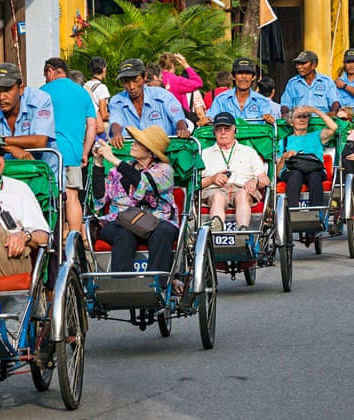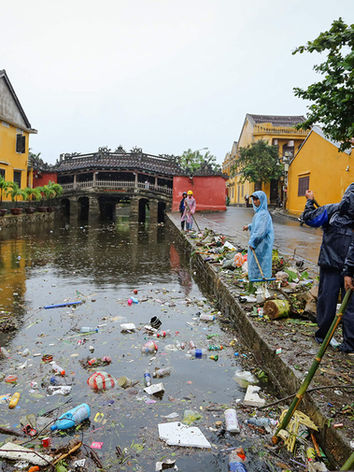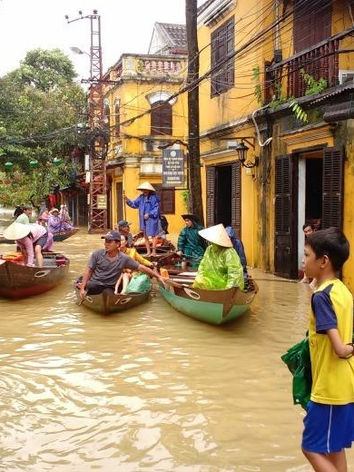

SAVE UNESCO'S
WORLD HERITAGE SITES

Hoi An Ancient Town is in central Vietnam south of Danang in Quang Nam Province. It is a historical vestige, a valuable cultural heritage appreciated for its significant worldwide. As one of Vietnam's seaports located on the "Silk Road on the Sea", it developed in the Asian trading system from the 16th to 19th century with the participation of traders and sojourners from Indonesia, China, Japan, India, Netherlands and England to name a handful.

At the beginning of the 19th century, trading activities fell into difficulties and stagnation and the local people lived on farming, fishing, and making handicrafts. In 1999, the Hoi An Ancient Town was inscribed in the World Cultural Heritage List. Hoi An Ancient City is 30 hectares with buffer zones of 280 hectares including its core zones, river buffer, natural wetlands and beaches. There is a population of approximately 121,716 people in 2021.
Hoi An Ancient Town is an exceptionally well-preserved example of a South-East Asian trading port dating from the 15th to the 19th century. Its buildings and street plan reflect the influences, both indigenous and foreign, that have combined to produce this unique heritage site. Hoi An Ancient Town has retained its traditional wooden architecture and townscape in terms of plot size, materials, façade and roofline. The town reflects a fusion of indigenous and foreign cultures as well as traditional dishes that produce this unique survival over the centuries, preserved along with the aid of older generations. Refer to Hoi An Ancient Town - UNESCO World Heritage Centre.
Outstanding Universal Value (OUV)
The significant values of Hoi An Ancient Town and culture lie in its integrity and authenticity. The Ancient Town has retained its original form and function as an outstanding example of a well-preserved traditional South East Asian trading port and commercial centre.
The surviving wooden structures and street plan are original and intact, together presenting a traditional townscape of the 17th and 18th centuries, the survival of which is unique in the region. To this day, the town continues to be occupied as a trading port and functions as the centre of commerce. The living heritage reflects the diverse communities, the indigenous inhabitants, as well as foreigners, that has been preserved and continues to be passed on for future generations.
The street plan, which developed as the town became a port, comprises a grid of streets with one axis parallel to the river and the other axis of streets and alleys set at right angles to it. Typically, the buildings front the streets for convenient customer access while the backs of the buildings open to the river allowing easy loading and off-loading of goods from boats.
Hoi An retains 1,107 timber buildings, streets, conventions, communal houses, shrines, churches, ancient wells and tombs. The architecture features traditional characteristics of Vietnam with cultural integration of China, Japan, of western countries along with their customs, rituals, cultural activities, beliefs, and traditions.


These original cultural and historic features demonstrate the town’s outstanding universal value that are present, well-preserved, and evident within the boundary of the inscribed property, even while it continues to function as a trading port and a popular tourist destination.
As a result of economic stagnation since the 19th century, it has not suffered development and there has not been pressure to replace the older wooden buildings with new ones in modern materials. It has ensured the town’s retention of the landscape and unique urban fabric, preserved in a remarkably intact state.
Identification of Threats


The major risk faced by the ancient town of Hoi An involves development pressure. This includes improvements intended for traffic, transportation, economic growth and improved living standards to build modern dwellings. Concomitant with the introduction of new technology, materials and construction, there has been a yearning to alter heritage buildings.
Majority of the property owners have given up their properties to tenants and want to change the structure of the houses to rebuild them in accordance with commercial functions. The Government and heritage conservation agencies are trying to manage these activities by applying regulations on conservation work, but they cannot control this negative development entirely. There are many people from other cities moving into the town to start commercial services and business activities. Such pursuits are changing and impacting the local traditional lifestyle, which is the soul of the World Heritage property.
Natural and cultural resources are important assets of the Hoi An City. They do not exist in an independent way, but they influence each other, generating interactions. Canebrakes, sand-dunes, mangrove forests, sea-grass beds, coral reefs, seaweed masses, and natural forests on its surrounding islands, coastal and marine areas, as well as on the landscape and seascape, provide the city of Hoi An with many ecological services, creating favourable conditions for socio-economic development, especially ecotourism.
Amongst these, most significant yet vulnerable areas resulting from the consequences of climate change are identified as hotspots to prioritize for remedial action.
The most important hotspot - Phuoc Thang village in Cam Kim, southwest of the city is known for agriculture, fisheries, flower growing and selling handicrafts.
The 2nd major hotspot is An Dinh and An Hoi neighbourhood, encapsulates the cultural and commercial heart of the city.
The 3rd hotspot is An My which is largely used for agriculture and eco-tourism. These places lack basic amenities with minimal access to communication, the internet, and even piped water. The well water that is used is saline and is unfit for drinking. Also, there is no drainage infrastructure, signalling an incapacity to cope with flood water.

Effects of overwhelming tourism rates impact the traditional culture of Hoi An. Tourism services have badly affected the townscapes will lead to environmental pollutions. The implications are directly impacting the people of Hoi An, the risks can hence be said to be high when compared against the framework for threat assessment.
As construction activities at the World Heritage Site were not permitted, and land close to the site was scarce and expensive, investors shifted to the beach and to the road leading to it. Most of the town’s mid-range hotels are built along this road, while the larger, more luxurious hotels emerging on the beach.
Secondly, there exists environmental pressures exacerbated by the dry season and rainy season. Changes in river currents cause silt, erosion and blockage of waterway such as changes in terrain and geology every year, affecting the foundation of relics. As a result, termites, bats, fungus, mosses are widespread, accelerating the degradation of heritage timber buildings.
The erosion at the Thu Bon river bank is further exacerbated by high waves and severe storms. Serious landslides have occurred along the Thu Bon river in the Thanh Ha, Cam Nam and Cam Thanh areas. For example, the Cua Dai area where Phuoc Trach was lost to erosion.
Due to the direct and irreversible effects of environmental agents on heritage assets and locals, the risks posed are high and mitigation measures are of dire necessity.

Assessment of Conservation Management Plans
Hoi An Ancient Town was classified as a National Cultural Heritage Site in 1985 and subsequently as a Special National Cultural Heritage Site under the Cultural Heritage Law of 2001 amended in 2009. The entire town is State property and is effectively protected by several relevant national laws and governmental decisions, such as Cultural Heritage Law (2009) and Tourism Law (2005).
The 1997 Hoi An Town Statute defines in regulations that are implemented by the Hoi An Centre for Monuments Management and Preservation, the responsible agency of the People’s Committee for the management of the property. Day-to-day management involves collaboration with various stakeholders, to maintain the authenticity and integrity of the property and to monitor socio-economic activities within and adjacent to the property.
The capacity of the professional staff has been and continues to be developed by many domestic and international training courses. Revenue from entrance tickets is invested directly in the management, preservation, and promotion of the property. Management and preservation are further strengthened through master planning and action plans at the local level such as regular restoration and conservation programmes.

In terms of environmental pressures, several mitigation strategies have been implemented to reduce the effects of flooding.
Currently, the Vietnam Ministry of Natural Resources and Environment aim at mitigating water seepage into buildings via methods such as mitigating contact of water by building a canal reservoir around the site which requires major modifications to the site.
Moreover, there are installations of temporary and permanent barriers to reduce damage due to flooding, to retain the originality of the archaeological site with snap - on covers for airbricks to mitigate water seepage or sandbag barrier as a surrounding wall. There are also permanent barriers like building of walls and installation of gates against heavy flooding.
Management measures help to minimise the damage after water have entered the building. Flood resilient works primarily focus on water containment and drainage. As a rule of thumb, flood water more than 1.0m in height is considered to pose a risk to the structural integrity of the site. Masonry walls are very likely to be damaged by inherent soluble salts absorbed in rising damp from groundwater. Furthermore, the timber work becomes prone to fungal and surface deterioration.
Suggested Conservation Management Strategies
Through the assessment, we propose a recommendation that the entire town becomes State property, protected by the Cultural Heritage Law (2001) and the Tourism Law (2005). There should be a multi-disciplinary research conducted by teams of international and national scholars on conservation and interpretation of the town’s heritage to preserve the landscape, townscape, architecture and all material and cultural artefacts. Scientific research on national and international organizations to regularly seek and expand methods to preserve, conserve, and promote sustainable legacy.
The buffer zone should be managed to protect the property from external threats. The potential adverse effects to the property caused by annual flooding and urbanization to be effectively controlled with the active participation of all authorities and local community.
Protection zones of historical and cultural relics and places of interests to be identified according to regulations of the Council of Minister. All activities including construction and development within the protected zones must obtain a permit from Ministry of Culture. Anyone who causes damages to historical and cultural relics and places of interest in the protected zones must be penalized according to state laws.


In the early 2000s after the inscription, members and inspectors of the People’s Committee of Hoi An were very serious about the implementation of UNESCO’s guidelines for protection and preservation. As these guidelines applied mainly to the structures, it is no wonder that most official attention and inspections focused on the houses, temples and other such structures.
Thus, long-term management should aim to promote improvement in the living conditions of residents. As tourism increases, efficient strategies for its management need to be sought within the parameters of the site. Strategies to deal with adverse effects of the climate are being developed and should be included in the Management Plan.

The End.
Bibliography
BSR, 2018, Building Climate Resilience in Southeast Asia A Framework for Private-Sectors Action, pp 31-33.
Engelhardt, R.A., Rogers P.R., 2009, Hoi An Protocols For Best Conservation Practice In Asia, Professional Guidelines for Assuring and Preserving the Authenticity of Heritage Sites in the Context of the Cultures of Asia, UNESCO Bangkok.
Hiroshi Takagi, Nguyen Danh Thao, Miguel Esteban, Takahito Mikami, Le Van Cong, Vu Thanh Ca, 2015, Handbook of Coastal Disaster Mitigation for Engineers and Planners, Chapter 12 - Coastal Disasters in Vietnam, pp 235-255.
H.T. Bui and Tuan-Anh Le, 2018, Case Study Vietnam: Climate Change Imparts on UNESCO Work Heritage – the Case of Hoi An Ancient Town, Bell and Bain Ltd., pp 191-199.
H.T. Bui, Jones, T. 2020, The adaptive resilience of living cultural heritage in a tourism destination, Journal of Sustainable Tourism, Volume 28, 2020 - Issue 7, pp 1022-1040.
Journal of World Heritage Studies, 2019, Nature: Culture Linkages in The Cu Lao Cham: Hoi An World Biosphere Reserve, pp 66-72.
Le Duc Toan, Phan Thanh Hai, 2002, Research on the determinants that form Hoi An world heritage tourism destination, Vietnam, Volume 8 (5)-(2019).
Quang Nam Provincial People’s Committee, 2014, VIE: Urban Environment and Climate Change Adaptation Project (Hoi An City, Quang Nam Province).
Rajib, S. 2006, Community-based climate change adaptation in Vietnam: inter-linkages of environment, disaster, and human security, Teri publication.
Tran Van Nhan, 2014, Building Hoi An Towards A Cultural City, Deputy Chief of the Secretariat of Hoi An’s Committee Office.
Tu Dam Ngoc, Lea Ripendra Awal, 2021, Chapter 9 - Adaptation to climate extremes and sea level rise in coastal cities of developing countries, Science Direct, pp 145-170.
UN-Habitat, 2014, Cities and Climate Change Initiative - A Bridge Report Hoi An, Vietnam Climate Change Vulnerability Assessment, United Nations Human Settlements Programme.
Hoi An Ancient Town - UNESCO World Heritage Centre
Hoi An Ancient Town - Documents - UNESCO World Heritage Centre

